Encouraging or Discouraging Broodiness in Your Hens
Since I started to raise chickens in August 2008, I have learned so much valuable information about raising chickens, but I still am learning something new all the time. Some of the best advice has been from this wonderful community of chicken lover’s on Backyard Chickens Forum. I’ve also gleaned a lot from reading books and magazines, as well as, hands-on experience. One of those things that I read about for several years, and then experienced for the first time in 2012, was a broody hen. Like most mothers in the animal kingdom, some hens have retained the natural instinct to raise their own young. Depending on your motives for raising chickens, this can be an added benefit or a great hindrance, both of which we’ll discuss in this article.
For those who are strictly interested in getting the most eggs out of their flock as possible, broodiness would not be a desirable trait. For the 2-3 months that the hen is broody, she won’t lay any eggs. The good news is that most of the modern high production breeds have been selectively bred and rarely “go broody”, including the Leghorns, Sex Links, Production Reds, & Rhode Island Reds. Many of the other breeds rarely go broody, but there are always a few exceptions.
Signs of a Broody Hen
Daisy all nestled down in the hay; Alix fluffed up and agitated, because I moved her off the eggs.
First, you need to know the “symptoms” of a broody hen. The most common sign is that she won’t come out of the nesting box for food or at roosting time. The hen may also fluff up her feathers, growl and peck at you, but that can happen if she’s just laying an egg. Many people refer on BYC Forum to a classic “broody stare” and “a broody hen pancake”. These two things are in reference to a somewhat “flattened” appearance caused by the fluffing of the feathers, spreading of the hen’s wings, closely tucked head and neck, and the hen’s chest tightly nestled into the nesting material. She will appear to be “one with the nest”, so as to be “invisible” and to provide the most heat for the eggs; which is quite evident if you reach underneath her. My broody hens always “screeched” when I went to check the eggs underneath them, and I would often have to “pry” them off the nest, as they wouldn’t want to stand up! A very determined broody hen will often pluck out her breast feathers (called a “broody patch”) to provide heat and humidity for the incubating eggs. Another way to “test” is to remove her from the nesting box and watch her actions. Sometimes, she’ll stay in the “sitting” position for a few minutes before starting to walk around. Often, they’ll also make a weird sound, like a “ticking”, and their feathers will be all fluffed out (to twice their normal size) when walking among the other hens. If they are truly broody, though, they’ll simply return back to sitting on the eggs, but they’ll often forget which nesting box they were in before.
Discouraging a Broody Hen
If you don’t want the broody hen to hatch out any eggs, the most common advice is to remove her from the nesting box or wherever she is sitting on the eggs. It’s best to place the broody hen in a brightly lit (not in full sun, though) isolation cage without bedding for several days to a week. I usually use a wire-floored rabbit cage and place it where she can see the other hens, but is out of the weather. If the hen is really determined, you might have to raise the cage up off the ground, so that air flows underneath. You still need to feed and water the hen, but the main idea is to prevent her from getting into the nesting boxes or wherever she wants to sit on those eggs. Some people have given their hens a cold bath, placed ice cubes under them in the nesting box, and many other hilarious methods that occasionally work. Most people have great success with “breaking a broody hen”, but some hens are very determined and will be constantly in the “Broody Buster Cage”. If you have a die-hard broody and don’t want to use her for hatching eggs, you might consider finding her a home who’d love to have a broody hen.
Encouraging and Utilizing a Broody Hen
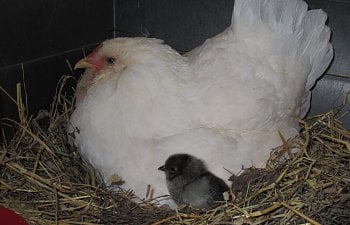
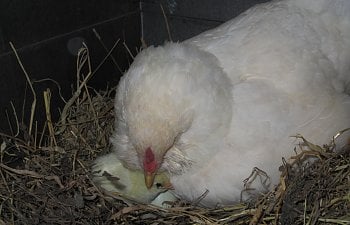
For those who are looking to be more self-sufficient in terms of raising replacements in their flock, broody hens are a very useful asset. Others love them simply as an “enabler” of the “Morehens disease” or for the cuteness of those fluffy little chicks. Broody hens don’t have to lay all the eggs they incubate, as they’ll gladly accept donations from the other hens in the flock. Broody hens can also be used to raise other species of poultry, including ducks and guineas. Some hens will even adopt chicks from a hatchery or an incubator, but other hens reject them. Everyone agrees, though, that whenever you move the hen or add chicks not hatched by the hen, it is best to do it when it’s dark. While you can’t hatch out as many chicks as you would in an incubator or order from a hatchery, it’s a fun way to raise baby chicks.
"Making a Hen Go Broody"
While many chicken keepers are eventually “blessed” with a broody hen, there are some who would like to “make a hen go broody”. Unfortunately, there isn’t a tried-and-true method to “make” a broody hen, due to that it’s mostly brought on by genetics, hormones and instincts. Some people, however, have been successful in encouraging a hen to go broody be leaving real or fake eggs in the nesting box. Or some will enclose them in a separate darkened area with a nest of (fake) eggs, in hopes that the hen will “become broody”. Most of the time, though, the hens will decide the best time to raise a clutch, and we have to adapt our “plans” to theirs. A lot has to do with the breed of the hen, but even with the common broody breeds such as Silkies, Cochins, Game Hens, Buff Orps, not every single hen will go broody. Then, there’s the unusual case where the less broody breeds will go broody, such as the Black Sex Link and White Easter Egger hens in my flock.
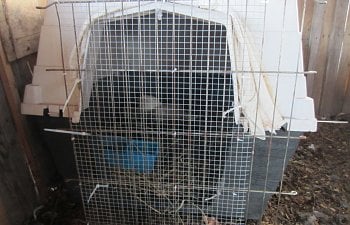
One of my Broody Hen Houses
Broody Hen Tips
Once you’ve determined that you indeed have a broody hen, and want her to hatch out some eggs, it is highly recommended to separate the broody hen from the rest of the flock – at night. Everyone seems to find a suitable “broody house”, whether it be a small chicken tractor, dog crate or house, 5 gal bucket, plastic bin, etc. For some, they simply close off the nesting box that the hen is already in. But, that requires manually removing the hen several times a day to eliminate waste, eat & drink. When you move the hen, you should place some fake eggs under her to make sure she stays broody. After at least 24 hrs, then you can place the unrefrigerated fertilized eggs under the broody hen. It is also important that the hen is in good health, as she will hardly eat during the 19-21 days she incubates the eggs. I would also make sure she gets off the nest for a potty break, especially if her area is too small to allow that. Another option is to fence off a small section outside of the broody house, and the hen will self regulate when to take breaks. Make sure, though, the hen cannot access the other nesting boxes in the coop. After she has had a dust bath, eaten & pooped, she will instinctively know to return back to her nest. But if her nest is next to a row of other nesting boxes, she may not return to the right one and cause the partially incubated eggs to die.
One of the other reasons it’s recommended to separate the broody hen is that other flock members might view the chicks as “intruders”. Especially when they rest of the eggs are hatching, and the mother hen can’t be there to protect a wandering chick. You also want to make sure they can’t squeeze through any fencing separating the broody hen and the rest of the flock. The general consensus is to wait until the chicks are at least 1 or 2 weeks old, before letting the broody hen and the chicks intermingle during the day with the rest of the flock. Some people, including myself, have been successful in allowing the broody hen and chicks forage during the day with the rest of the flock from only a day or two old, but I would be cautious, as it may not work for everyone.
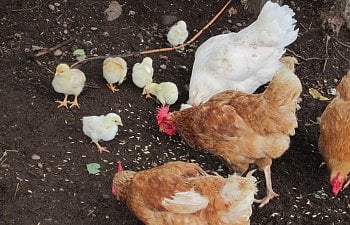
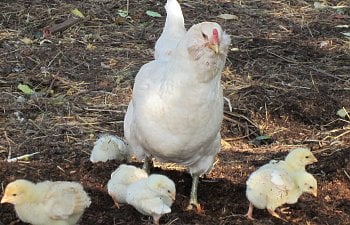
Daisy the Broody Hen with the Meat Chicks and Other Hens Eating Whole Oats; Teaching them to Scratch for Bugs in the Compost
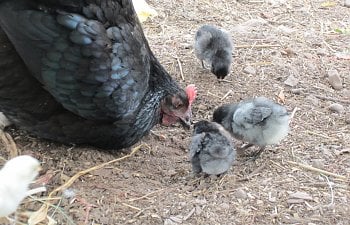
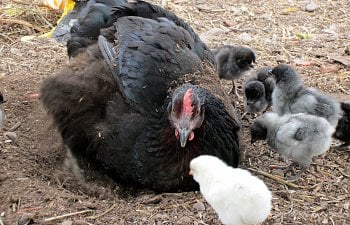
Black Willow Alix teaching her chicks what's good to eat and how to dust bath
Benefits of a Broody Hen Raising Chicks
There are many benefits to having a broody hen raise the chicks, rather than by a human. Even if the eggs are hatched via incubator or the chicks are from a hatchery, I personally think that the broody hen does a great job raising them. Not only do you save money by not having to use a heat lamp, but you can also save a little food cost. The mother hen teaches the chicks from a very early age how to forage their own food, often much sooner than if we humans were raising the chicks. She has a food call very similar to a rooster, which she uses to call the chicks to her when she’s found a tasty morsel. Plus, a broody hen will gradually integrate the young chickens into the rest of the flock, causing less pecking and commotion. Some broody hens will even teach the chicks to roost with the other birds inside the coop. I personally love watching the interaction between the mother hen and chicks, and how they learn to copy her every movement. For each hen, it will vary how long she stays with the chicks, but most will stay with them for around 6-8 weeks. She will gradually let the chicks wander around on their own, and leave them for a few minutes at a time. Even after the chicks have “graduated” into independence, the broody hen may once in awhile “check” on them.
Daisy's Brood Roosting in the Big Girl's Coop at 1 Month Old!
Disadvantages of a Broody Hen Raising Chicks
There are only about two minor “disadvantages” that I can think of. One would be that the chicks tend to be more “wild” and not a friendly as those I’ve hand raised. I think if you make an effort to spend time handling them, even while they’re with the mother, they might be friendlier than mine have been. The second would be the feeding issue. Most chicks need higher protein feed, and the other chickens in the flock love to steal the chick’s food. I “solved” this by feeding them in the morning and evening when they were cooped up in their own house, separate from the hens. With the second batch of broody hen raised chicks, I fermented the layer mash/chick grower, whole oats, alfalfa pellets & day old bread, and fed that to everyone in the flock. The hens continued to lay well, and the chicks grew great, and they self-adjusted their diet by foraging for the rest.
Why I Love Broody Hens
So, whether you decide that you want to discourage or encourage your broody hen, they both have great advantages. Even if you don’t want any more hens or roosters to keep for eggs, I had one of my broody hens raise a small batch of meat chickens. Those normally lazy Cornish Rock chicks were taught by the broody hen to forage, dust bath, run & jump. Even up to their last day, they were very active, even flying up on top of the compost pile, and scratching through it for bugs. That’s why I love broody hens. Not only they excel at teaching the “young’ins” what being a chicken is all about, but it’s also the most natural way. I see it as their way of fulfilling the blessing they were given after being created:
“Be fruitful and multiply … and let the birds multiply on the earth.”
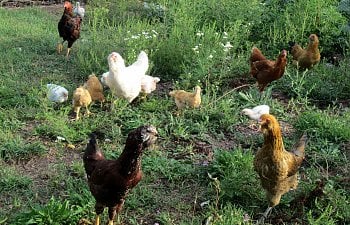
You might find this Broody Hen Thread interesting, but I’ve got to warn you:
Once you start reading, it’s very hard to stop!
https://www.backyardchickens.com/t/...ody-hen-hatch-a-long-and-informational-thread
All photos in the article are from my own flock, and taken by me.

